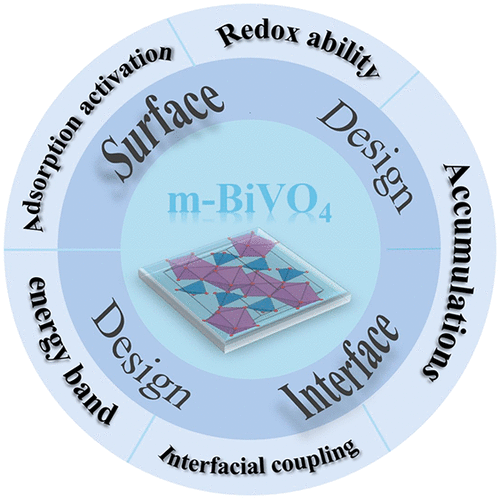当前位置:
X-MOL 学术
›
ACS Catal.
›
论文详情
Our official English website, www.x-mol.net, welcomes your
feedback! (Note: you will need to create a separate account there.)
Facet-Engineered Surface and Interface Design of Monoclinic Scheelite Bismuth Vanadate for Enhanced Photocatalytic Performance
ACS Catalysis ( IF 11.3 ) Pub Date : 2019-12-26 , DOI: 10.1021/acscatal.9b03411 Sha Chen 1, 2 , Danlian Huang 1, 2 , Piao Xu 1, 2 , Xiaomin Gong 3 , Wenjing Xue 1, 2 , Lei Lei 1, 2 , Rui Deng 1, 2 , Jing Li 1, 2 , Zhihao Li 1, 2
ACS Catalysis ( IF 11.3 ) Pub Date : 2019-12-26 , DOI: 10.1021/acscatal.9b03411 Sha Chen 1, 2 , Danlian Huang 1, 2 , Piao Xu 1, 2 , Xiaomin Gong 3 , Wenjing Xue 1, 2 , Lei Lei 1, 2 , Rui Deng 1, 2 , Jing Li 1, 2 , Zhihao Li 1, 2
Affiliation

|
Monoclinic scheelite bismuth vanadate (mBiVO4) has gradually been in the limelight in recent years because of its great potential in energy conversion and environmental remediation. However, the rapid recombination of photogenerated electron–hole pairs in mBiVO4 have impeded the improvement of its photocatalytic performance and stability. Therefore, important issues are increasingly focused on fine-tuning the physicochemical properties of mBiVO4 at the atomic level based on facet-engineered surface and interface design to optimize its selectivity and activity. Herein, the review begins with the fundamental aspects of mBiVO4 semiconductor, including crystal structure, optical properties, electronic structure, and photocatalytic principles. Then the synthetic methods based on surface and interface design that develop to tailor the facet of mBiVO4, along with the discussion of the mechanisms for facet-dependent photocatalytic performance, are presented. Most importantly, the latest advances in facet engineering that have been performed to regulate the surface of single mBiVO4 and to design the interface structures that are directly involved in the photocatalytic reaction for mBiVO4-based composites are encompassed. Moreover, the photocatalytic application achievements with mBiVO4 as photocatalysts in energy conversion and environmental remediation are also summarized. Finally, perspectives on the existing challenges and future research directions for this emerging frontier are discussed.
中文翻译:

单斜面白钨矿钒酸铋的刻面工程化表面和界面设计增强了光催化性能
近年来,单斜白钨矿钒酸铋(m BiVO 4)由于在能量转换和环境修复方面的巨大潜力而逐渐成为人们关注的焦点。然而,m BiVO 4中光生电子-空穴对的快速重组阻碍了其光催化性能和稳定性的提高。因此,越来越多的重要问题集中在基于面设计的表面和界面设计以优化其选择性和活性,从而在原子水平上微调m BiVO 4的理化性质。在这里,回顾从m BiVO 4的基本方面开始半导体,包括晶体结构,光学特性,电子结构和光催化原理。然后介绍了基于表面和界面设计的合成方法,这些方法可开发出适合m BiVO 4的刻面,并讨论了刻面依赖性光催化性能的机理。最重要的是,涵盖了小平面工程方面的最新进展,这些最新进展是为了调节单个m BiVO 4的表面并设计直接参与基于m BiVO 4的复合材料的光催化反应的界面结构。此外,m BiVO的光催化应用成就本文还对作为能量转化和环境修复中的光催化剂的4进行了总结。最后,讨论了对这一新兴领域的挑战和未来研究方向的观点。
更新日期:2019-12-27
中文翻译:

单斜面白钨矿钒酸铋的刻面工程化表面和界面设计增强了光催化性能
近年来,单斜白钨矿钒酸铋(m BiVO 4)由于在能量转换和环境修复方面的巨大潜力而逐渐成为人们关注的焦点。然而,m BiVO 4中光生电子-空穴对的快速重组阻碍了其光催化性能和稳定性的提高。因此,越来越多的重要问题集中在基于面设计的表面和界面设计以优化其选择性和活性,从而在原子水平上微调m BiVO 4的理化性质。在这里,回顾从m BiVO 4的基本方面开始半导体,包括晶体结构,光学特性,电子结构和光催化原理。然后介绍了基于表面和界面设计的合成方法,这些方法可开发出适合m BiVO 4的刻面,并讨论了刻面依赖性光催化性能的机理。最重要的是,涵盖了小平面工程方面的最新进展,这些最新进展是为了调节单个m BiVO 4的表面并设计直接参与基于m BiVO 4的复合材料的光催化反应的界面结构。此外,m BiVO的光催化应用成就本文还对作为能量转化和环境修复中的光催化剂的4进行了总结。最后,讨论了对这一新兴领域的挑战和未来研究方向的观点。













































 京公网安备 11010802027423号
京公网安备 11010802027423号